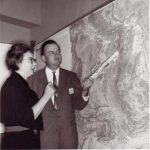Marie Tharp (30 July, 1920 – 23 August, 2006) was an oceanographer and cartographer who mapped the oceans of the world. She worked with Bruce Heezen, who collected data on a ship, mapping the ocean floor.

Tharp turned the data into detailed maps. At that time women were not allowed to work on research ships, as it was thought that they would bring bad luck! However, Tharp was a skilled cartographer, and as she made her maps of the floor of the oceans of the world, with their ridges and valleys, she realised that there were deep valleys which showed the boundaries of continental plates. She noticed that these valleys were also places with lots of earthquakes and she became convinced of the basics of plate tectonics and continental drift.
Between 1959 and 1963, Tharp was not mentioned in any of the scientific papers published by Heezen, and he dismissed her theories disparagingly as “girl talk”. As this video from National Geographic shows, she stuck to her guns and was vindicated by the evidence, eventually managing to persuade Heezen, and the scientific community at large, of the validity of the theories. In 1977, Heezen and Tharp published a map of the entire ocean floor. Tharp obtained degrees in English, Music, Geology and Mathematics during the course of her life. In 2001, a few weeks before her 81st birthday, Marie Tharp was awarded the Lamont-Doherty Heritage Award at Columbia University, in the USA, as a pioneer of oceanography. She died of cancer in 2006.
The National Geographic video provides an excellent testimony to this woman pioneer in oceanography.

My 9 year old son fell in love with all the aspects of this program - the simple but still…
Cara, Parent